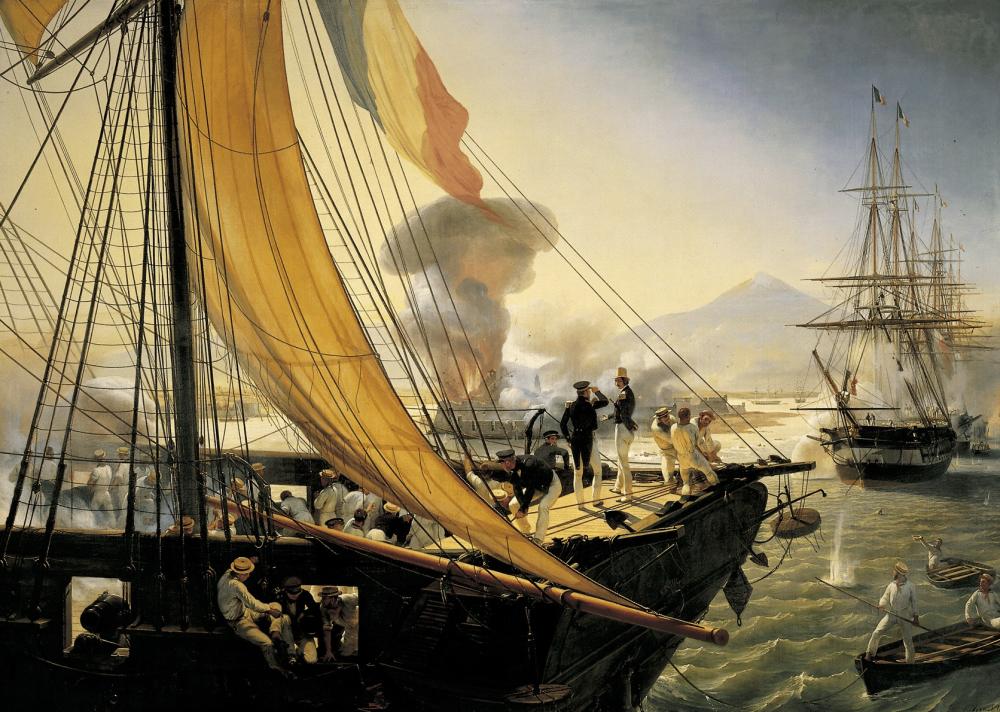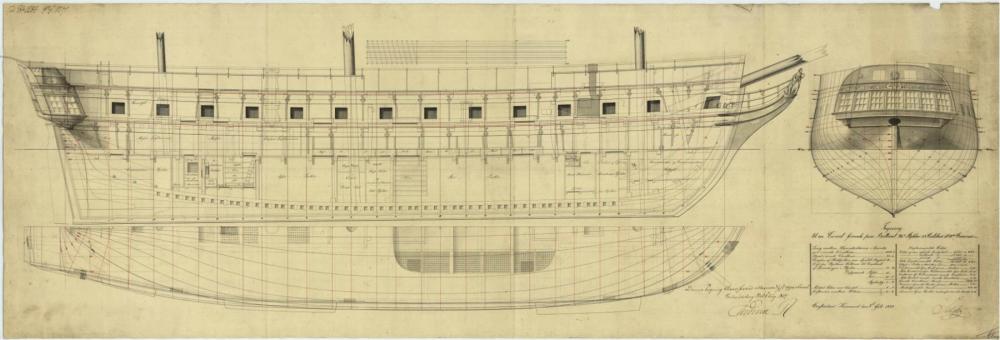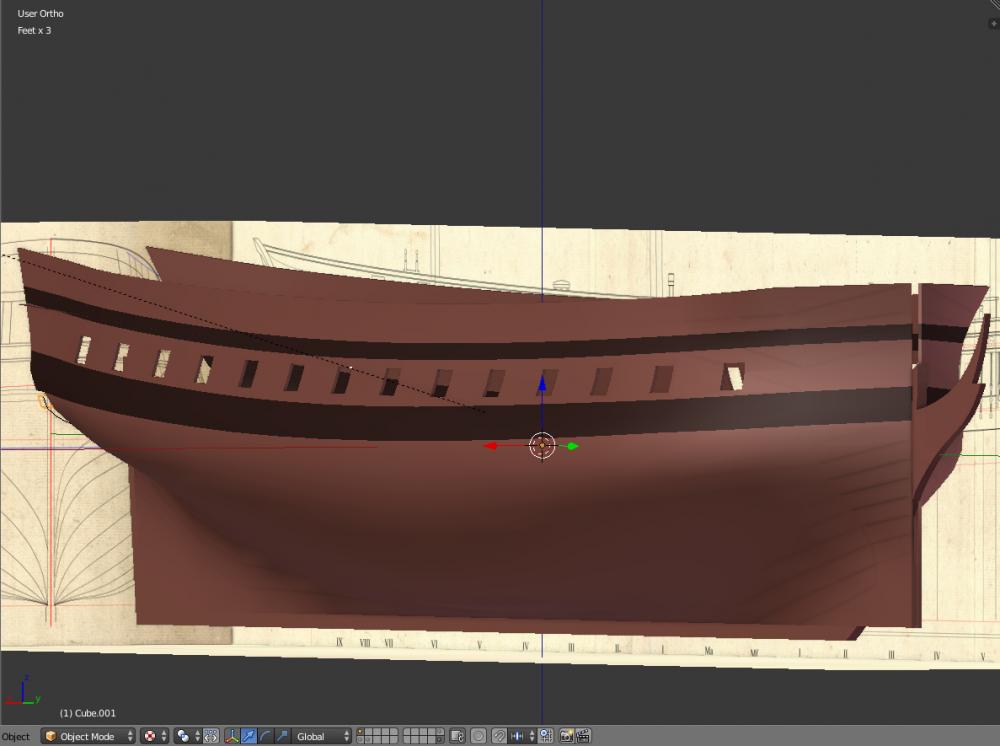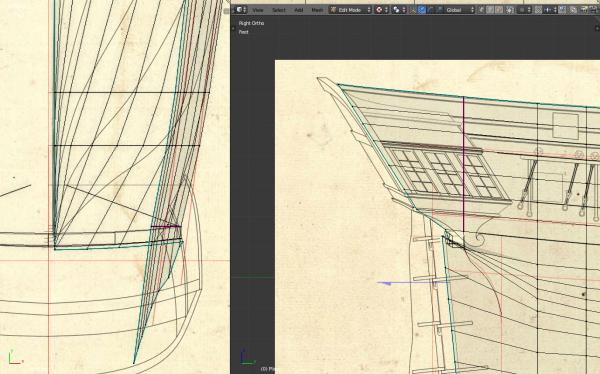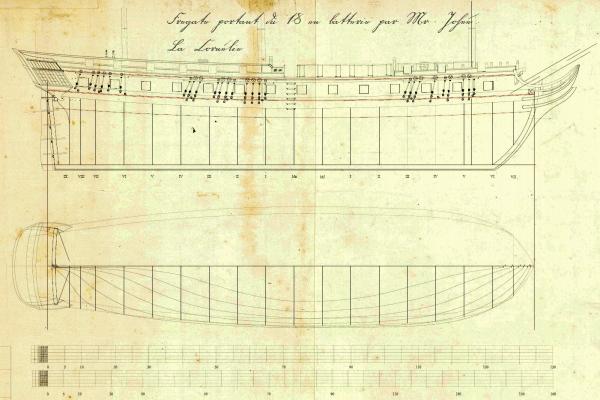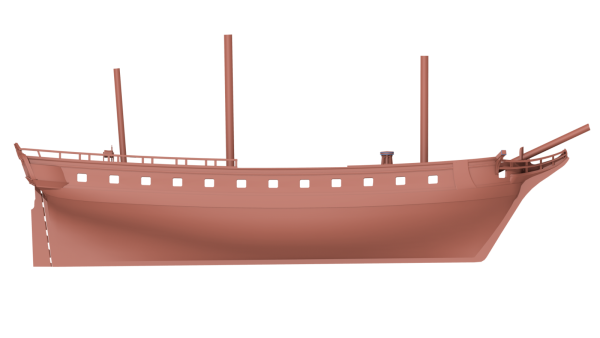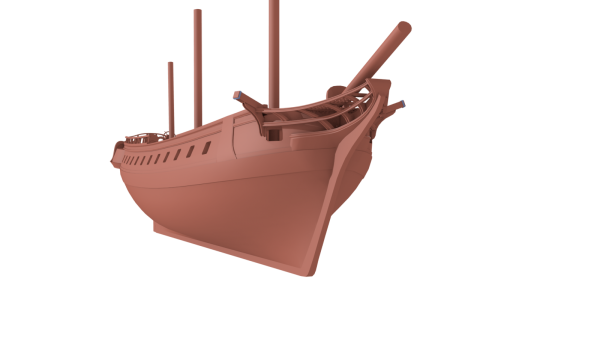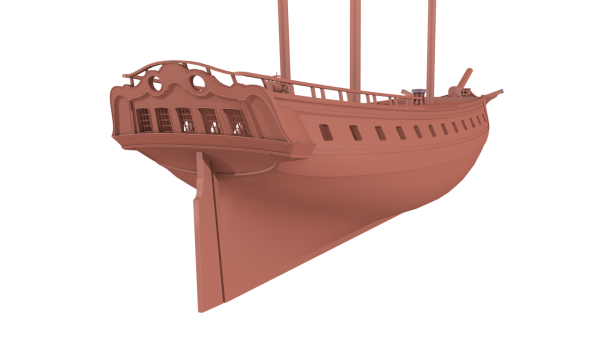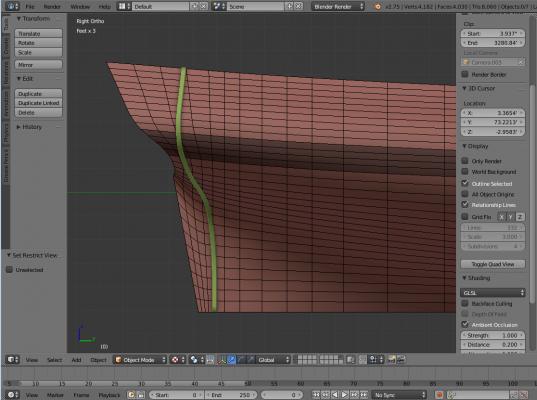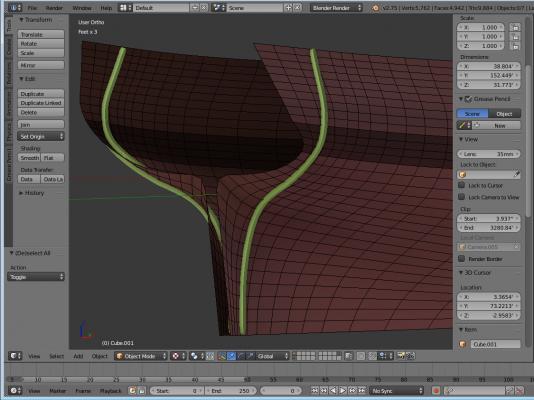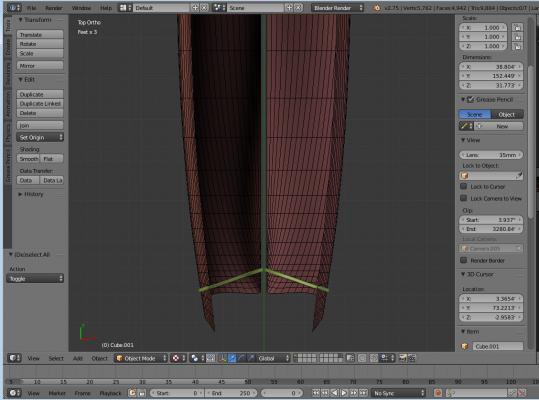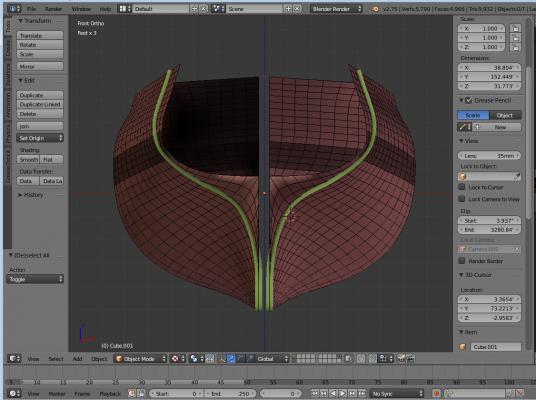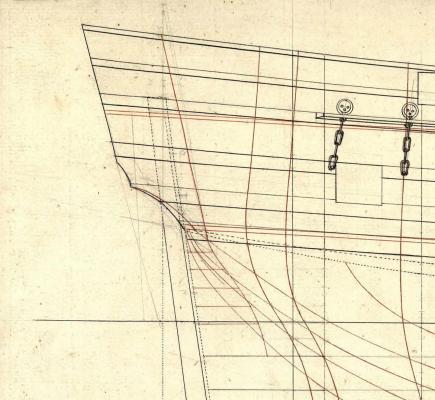-
Posts
121 -
Joined
-
Last visited
Content Type
Profiles
Forums
Gallery
Events
Everything posted by malachy
-
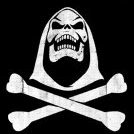
Frégate d'18 par Sané , la Cornélie
malachy replied to JohnE's topic in CAD and 3D Modelling/Drafting Plans with Software
We´re good at nit-picking, aren´t we? And thank you very much for the email!! Sent my request today, maybe there will be two versions of La Cornélie, one according to your plans and one as La Cybéle as a frégate rasée. -
Super Arbeit, Johann, bin echt begeistert! And you probably already know this painting, but I think it´s worth showing: Épisode de l'expédition du Mexique en 1838 by Horace Vernet. It shows the Prince of Joinville on the poop of La Créole, listening to the reports of the vessel´s Lieutenant, Penaud and sees the explosion of the tower of the Fort of Saint-Jean d'Ulloa on 27 November 1838. By the way, do we know anything about the sailing qualities of La Créole?
-

Frégate d'18 par Sané , la Cornélie
malachy replied to JohnE's topic in CAD and 3D Modelling/Drafting Plans with Software
Oh, là, là...good work as always, John! My fingers are itching and Blender is ready -

Frégate d'18 par Sané , la Cornélie
malachy replied to JohnE's topic in CAD and 3D Modelling/Drafting Plans with Software
Oh my...that´s beautiful, my compliments to the Unknown Artist™ I hope I can do the drawings justice in 3D. -

Frégate d'18 par Sané , la Cornélie
malachy replied to JohnE's topic in CAD and 3D Modelling/Drafting Plans with Software
That gave me a good chuckle, too. Looking forward to work with the next version of the lovely Cornélie, John! -

Seeking information on determining load waterline
malachy replied to trippwj's topic in Nautical/Naval History
Very interesting posts, trippwj! I´m looking forward to the next installment -
I´d love to see some french frigates, too. La Forte or maybe La Virginie. Or a danish one, they built beautiful vessels like Hohlenberg´s 24-pounder frigate Perlen of 1805: Another beauty, Schifter´s Galathea: Launched 1833 and made the first danish circumnavigation of the globe in the years 1846/47.
-

Frégate d'18 par Sané , la Cornélie
malachy replied to JohnE's topic in CAD and 3D Modelling/Drafting Plans with Software
Finally got the time to do some modelling: Model is still very rough around the edges (literally), but it should give a first impression of the hull shape. Which is, needless to say, very elegant John, any big chance for the plan upcoming or can I continue with the set you gave me? -

Frégate d'18 par Sané , la Cornélie
malachy replied to JohnE's topic in CAD and 3D Modelling/Drafting Plans with Software
I feel your pain, John. Bought a new comp one month ago and it took me 2 weeks to set things up...still have a lot of programs to install. But the move was well worth it, boot up phase takes 5 seconds and Blender/Gimp run smooth like silk. I´d suggest some Boccherini or Lully as background music when doing the tedious stuff. Calms me down nicely -

Frégate d'18 par Sané , la Cornélie
malachy replied to JohnE's topic in CAD and 3D Modelling/Drafting Plans with Software
John, one question: the red line on your half-breadth is the upper deck, I suppose? I have a little problem with our good old friend, l'estain. I finally have spare time for modelling again after two very busy weeks at work. Feels good -

Seeking information on determining load waterline
malachy replied to trippwj's topic in Nautical/Naval History
Harris' biography about af Chapman has a very interesting appendix with Chapman´s hand-written calculations for a 70-gun ship, made in 1767. He calculated: - displacement volume (with two methods, integration of the cross-sectional areas at each station and integration of the areas of each waterplane) - location of the centre of bouyancy - centre of flotation - location of the metacentric heigth above the load waterline Well worth a look if one wants to know how they did things back then -

Frégate d'18 par Sané , la Cornélie
malachy replied to JohnE's topic in CAD and 3D Modelling/Drafting Plans with Software
She already is a beauty, John, a beautiful french lady. And it looks like this plan is going to be an absolute joy to work with Edit: Looks like the original plan for La Cornélie has been found in the archives...your version is spot on, John! Why Sané is mis-spelled Johné and it has a scale with french and british feet is still a mistery for historians, though. -
Well observed, she has a pretty sharp bow and a fine run. A bit difficult to see on the pictures, though. Frigates with 24 guns on the upper deck were pretty common in the swedish and danish navy before the 1780s, probably because they preferred shorter - thus cheaper - ships with rather fine lines combined with british construction features. Chapman´s ten ships of the Bellona-class were the first frigates in the swedish navy with a conventional 26-guns setup (they carried 24-pounders, by the way). And the forward-most gun port at the position of the foremast was a typical design feature of Chapman, maybe comparable to earlier french frigates like La Renommée or La Belle Poule. Ha, you´re not the first to compare this ship to the Triton, got the same response on another modelling board Triton was made of pine, right?
-
Hi folks! I started this little project as a simple study on how the body plan would translate into a 3D shape but I liked what I saw so I continued and added further details. It´s by no means finished and there are a lot of things still to do. The draught can be found in D. Harris' highly recommendable biography about the swedish shipwright Frederik af Chapman. It´s part of a series of drafts, ranging from a snow to a 110-gun ship, which have been made by af Chapman in 1798. Out of this series, only three ships were actually launched, a brig, a 74-gun ship and the 24-pounder frigate af Chapman. This frigate was designed to intercept danish smugglers at the west coast of Sweden and pierced for 24 18-pounders on the upper deck plus 12 6-pounders on the quarterdeck and forecastle. But, due to lack of funds, it was never built. Dimensions (imperial feet): length p/p: 145' 2'' breadth: 36' 9' draught aft: 16' 9'' height of the middle gun port above the water: 6' 10'' length-to-breadth ratio: 3,95 I found the rather modest armament in relation to the size especially interesting. For comparison, af Chapman´s Bellona-class, which consisted of ten frigates launched between 1783 and 1785, measured 151' 11' p/p and carried 26 24-pounders and 14 6-pounders. This may be an indication that this ship was designed primarily for speed, not firepower. (but it´s not like that Chapman´s ship were slow, quite the contrary, the Bellonas were capable of going 14 knots and the af Chapman is described as the 'meilleure marcheuse de son temps' - the fastest ship of her time - in the french Atlas du Genie maritime, published in the mid-1830s). But enough of the talking, here are some WIP pictures:
-

Frégate d'18 par Sané , la Cornélie
malachy replied to JohnE's topic in CAD and 3D Modelling/Drafting Plans with Software
Never seen the Renommée model from the front or back, but wouldn´t the hull shape give the most obvious hint whether she was designed by Forfait (or one of his 'disciples' like Degay, LeTellier, Gauthier or Pestel) or not? Edit: Hm, here´s the model in question. In picture number four, the hull does indeed look V-shaped, but the absence of any significant tumblehome (unlike Forfait´s Seine- or Gloire-class) makes me think that either Gauthier or Pestel could have been responsible for the design, probably the latter. And Pestel usually gave his frigates bridle ports, as can be seen on his Nereide. Edit: after some digging, I´ve found the plan for La Renommée in the 'CATALOGUE DES PLANS DE BÂTIMENTS À VOILES CONSERVÉS DANS LES ARCHIVES DE LA MARINE'. It´s the same as for Pallas, Elbe and Chlorinde, all built at Basse-Indre (Nantes) and signed by a certain Bonjean, but all three were part of Sané´s Pallas-class. By the way, what´s 'Éch. Pl. vertical'? Is that just the body plan? -

Frégate d'18 par Sané , la Cornélie
malachy replied to JohnE's topic in CAD and 3D Modelling/Drafting Plans with Software
Beautiful, citoyen John. You really did her Justice ( ). -

Frégate d'18 par Sané , la Cornélie
malachy replied to JohnE's topic in CAD and 3D Modelling/Drafting Plans with Software
Impressive, indeed! Looks like the plan is coming along nicely, citoyen JohnE -

Frégate d'18 par Sané , la Cornélie
malachy replied to JohnE's topic in CAD and 3D Modelling/Drafting Plans with Software
Quite an interesting and helpful line, that. Here´s what it can look like in 3D: Not canted the right way at all areas and too thick but it should be helpful to unterstand the concept. Just noticed this in the first post. Are the 'superior sailing qualities' described in detail? -

Frégate d'18 par Sané , la Cornélie
malachy replied to JohnE's topic in CAD and 3D Modelling/Drafting Plans with Software
This is how it looks on the sheer, by the way: It´s for a danish ship but they used french methods at the time. What´s really puzzling is that the red lines are perfectly straight on the waterlines plan. (and sorry for derailing your thread, John) -

Frégate d'18 par Sané , la Cornélie
malachy replied to JohnE's topic in CAD and 3D Modelling/Drafting Plans with Software
Me likes. A lot. I´m trying to find a nice project for a 3D model for a while now and the Pallas by Sané is in the top 4. The other are Forfait´s Seine, the Termagant (a Brit, but based on the lines of the french privateer Pomona) and L`Embuscade of 1789 (french, but the design seems to be heavily inspired by F. af Chapman). Will follow your log with great interest, citoyen JohnE! -

British 'Termagant', 1780, ship-rigged Sloop - Info?
malachy replied to malachy's topic in Nautical/Naval History
Sure http://digitaltmuseum.se/search?page=6&query=Ritning,%20Chapman I only searched for Ritning (drawing) and Chapman, you may get better results with a broader set of keywords/options (e.g. just ritning and a period setting of 1750 to 1800) as some drawings may not be tagged with 'Chapman'. Best way to get a high resolution pic is to right-click on the download button and choose 'save target as...' and don´t forget to add the file extension. If you click on the picture itself, you get a smaller version most of the time. For example, Chapman´s drawing of the stern/head of the Fleuron is 3000*1700 pixels when downloaded, the 'preview' picture in the slide show is only 1500*850. The 'order image' gets you to an order form where you can obtain the full-sized image, either as a print or a digital copy. The resolution of the scan can be seen in the Archive submenu of the museum main page (usually in the 10000 to 20000 pixel range). A copy costs 20 Euros.
About us
Modelshipworld - Advancing Ship Modeling through Research
SSL Secured
Your security is important for us so this Website is SSL-Secured
NRG Mailing Address
Nautical Research Guild
237 South Lincoln Street
Westmont IL, 60559-1917
Model Ship World ® and the MSW logo are Registered Trademarks, and belong to the Nautical Research Guild (United States Patent and Trademark Office: No. 6,929,264 & No. 6,929,274, registered Dec. 20, 2022)
Helpful Links
About the NRG
If you enjoy building ship models that are historically accurate as well as beautiful, then The Nautical Research Guild (NRG) is just right for you.
The Guild is a non-profit educational organization whose mission is to “Advance Ship Modeling Through Research”. We provide support to our members in their efforts to raise the quality of their model ships.
The Nautical Research Guild has published our world-renowned quarterly magazine, The Nautical Research Journal, since 1955. The pages of the Journal are full of articles by accomplished ship modelers who show you how they create those exquisite details on their models, and by maritime historians who show you the correct details to build. The Journal is available in both print and digital editions. Go to the NRG web site (www.thenrg.org) to download a complimentary digital copy of the Journal. The NRG also publishes plan sets, books and compilations of back issues of the Journal and the former Ships in Scale and Model Ship Builder magazines.



